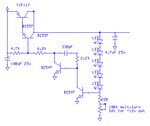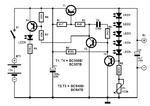neazoi
Advanced Member level 6
Hello I have found this regulator **broken link removed**
I have tested it and works like a charm. I have also managed to take other output voltages (8v) by adding some more leds and another potentiometer.
My question is, can I ingrease the output current which is now only about 20mA?
I have attached a proposition for this, coult wou tell me if this is ok?
Basically I am forming a pnp darlington by the use of 2 transistors. Will the small bc557 drive ok the big tip117? (I will consume about 1-1.5A max out of the PSU)
I have tested it and works like a charm. I have also managed to take other output voltages (8v) by adding some more leds and another potentiometer.
My question is, can I ingrease the output current which is now only about 20mA?
I have attached a proposition for this, coult wou tell me if this is ok?
Basically I am forming a pnp darlington by the use of 2 transistors. Will the small bc557 drive ok the big tip117? (I will consume about 1-1.5A max out of the PSU)

